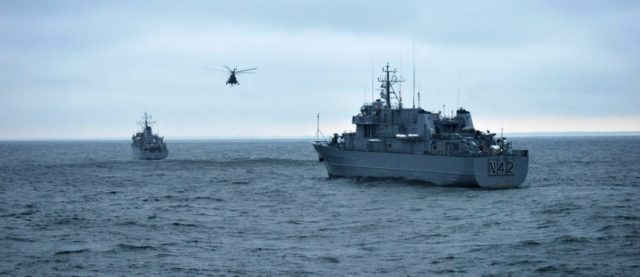
Baltics Take Step Toward Creating Single Security Space
Publication: Eurasia Daily Monitor Volume: 14 Issue: 35
By:

The issue of closer defense cooperation among the three Baltic States—Lithuania, Latvia and Estonia—was raised again, on March 3, by defense professionals and distinguished speakers from the United Kingdom and the United States, during a conference on “Social Resilience Against Hybrid Threats in the Baltic Region.” The international gathering, held at the parliament building in Vilnius, Lithuania, was organized by the Lithuanian National Defense Foundation. From a military point of view, the three Baltic States geographically are located within a single region of operations. This leads to an interdependence between them, wherein the fall of one country would inevitably affect the others (La.lv, March 3).
The Baltic States cooperate on an inter-parliamentary and inter-governmental level, a relationship that was institutionalized as early as November 1991, with the founding of the Baltic Assembly. In military operational terms, meanwhile, the closest cooperation was established in 1994 under the BALTNET joint regional aerial surveillance project (Mil.ee, December 19, 2012). In addition, one of the most sustaining joint projects among the three post-Soviet Baltic republics has been the Baltic Naval Squadron (BALTRON), whose aim is to improve the permanent preparedness of the Baltic navies’ mine detection vessels (Mil.ee, January 6, 2015). BALTRON operations train the participating crews to handle both national tasks as well as missions connected to the North Atlantic Treaty Organization’s (NATO) naval mine countermeasures group. Finally, one of the greatest successes of Baltic tripartite military cooperation has been the Baltic Defense College (Mod.gov.lv, Accessed February 6).
Nevertheless, the turning point in cooperative Baltic relations came soon after the Russian invasion of Ukraine. On February 18, 2015, the Baltic States established the Combined Joint Staff Element as a framework for closer military cooperation, the coordination of their defense planning, capacity building of their land forces, as well as joint military intelligence (Sargs.lv, February 18, 2015). Moreover, since 2016, the Baltic States have applied to participate in the NATO Response Force with a joint battalion unit (BALTBAT)—an opportunity to deepen and develop their military coordination and increase their Armed Forces’ mutual compatibility (Mod.gov.lv, accessed February 6).
The Lithuanians, in particular, have an especially ambitious vision for Baltic military cooperation: they desire to create a common Baltic division. However, Nora Vanaga, a researcher at the National Defense Academy of Latvia, believes that under existing circumstances, even creation of a joint brigade-size unit would be impossible to achieve. All three countries have a limited number of military personnel and resources, and there is no one who could command such a division, Vanaga argues. In turn, Latvian parliamentarian Jānis Ādamsons asserted last month that Lithuania, Latvia and Estonia would be unable to form anything larger than a joint Baltic Brigade because only about 2,000 to 3,000 soldiers exist to be drawn from within the current regional security environment. “If necessary,” he added, however, “this unit could be used not only in the Baltic countries, but also elsewhere” Ādamsons (Latvijas Avīze, February 8).
Latvian defense ministry official Edwards Seliška has dismissed the idea of forming a joint Baltic military unit, noting that “there is [already] ongoing cooperation between Baltic land forces on a daily basis through exercises and training, which provides a certain format for joint force formation.” According to Seliška, there is no need for a large joint unit, because it is too expensive.
Speaking with the author, on February 3, Dr. Māris Andžāns, of the Latvian Institute of International Affairs, commented that there is still a significant space for enhancing defense and security related cooperation among the Baltic States. Opportunities sparked by the “post-Crimea situation” should be further utilized. Cooperation among the Balts’ Armed Forces should be strengthened via common procurements and the integration of both strategic and tactical planning, in particular, he stressed.
Past inadequacies in joint procurement stem from differences in funding procedures and varying levels of development of the Baltic republics’ Armed Forces. For instance, the Latvians purchased used armored personnel carriers, while Estonians were buying completely new and more advanced models. In addition, the current administrative and legal framework can actually make joint purchases much more expensive. As an example, the Balts’ joint procurement of ammunition for the “Carl Gustav” anti-tank system, administered by the European Defense Agency, escalated the price by 20 percent (Sargs.lv, August 5, 2016).
On the other hand, one of the Baltic States’ greatest shared successes in recent years came out of the NATO Warsaw Summit (July 2016), wherein the Alliance collectively agreed to deploy multinational battalions to each of these countries and Poland. Papering over any pre-existing differences in strategic vision, there is now a common perception that NATO needs to maintain a “united frontline” in the Baltic region. Frequent military training and exercises within the framework of deterrence and collective defense provide for common operational thinking in the region. And this significantly improves all the elements of Host Nation support while, importantly, ensuring ever greater interoperability of the Balts’ militaries with other allied countries’ armed forces—and with each other.
Thus, despite the existing disagreements and differences among the three Baltic countries, there is strong promise that further integration of their militaries will continue. Increasingly, the Baltic States believe that joint and synchronized actions are crucial to successfully withstand both the conventional and asymmetric threats originating from their common adversary.



